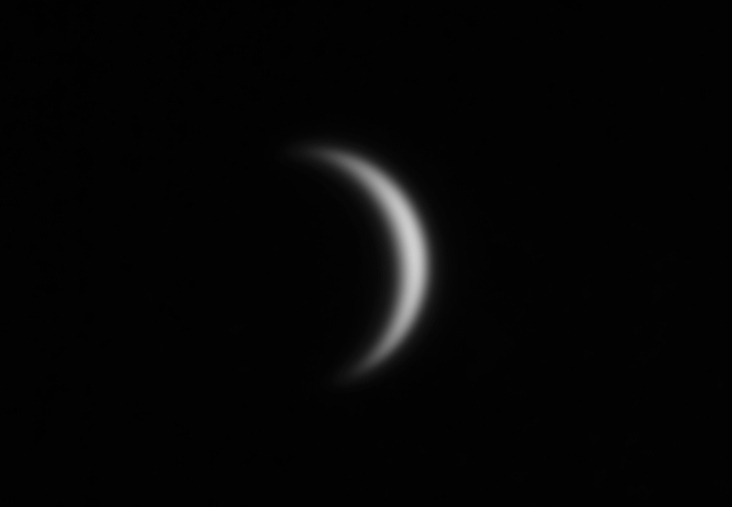
Crescent Venus, NGC288 Globular Cluster,
NGC1977 and M42 Nebulae
Posted: 25 December 2013
|
Opened: Tuesday, 24 December 2013, 1809 MST Temperature: 55°F |
Session: 631 Conditions: Clear, calm |
Just prior to opening the observatory, I took this photo, f/3.8, 1/20sec, ISO 1600, showing the dome and Venus:

At 1816 MST, viewed Venus, 83X through the 8" telescope. Seeing was much better this night than on the previous session. I began setting up for imaging of Venus. I did some eyepiece projection (222X) HD video recording using the D7000 DSLR at several exposure settings. This is a stack of 289 frames from a 1/1000sec, ISO 6400, video using Keith's Image Stacker:

I removed the camera and did some observing of Venus using the 2" 9mm eyepiece + 2" 2X PowerMate. The view was very good. I tried imaging Venus with the iPhone 5s using afocal 444X but Venus would overexpose. I switched to a 1.25" 9.7mm eyepiece + moon filter + 2X PowerMate (yielding 412X) and did some video recordings using the iPhone 5s. This is a crop (done on the iPhone) of one frame from a video:

I did some more Venus observing at 412X with the moon filter. Venus was lovely. I stepped away from the telescope for a few minutes and looked at the Milky Way glowing nicely overhead. It ran from the west to the east. I then did some more Venus observing at 222X.
Beginning at 1858 MST, viewed NGC253 (Sculptor Galaxy). I tried 222X but that was too much magnification for the faint galaxy. Switched to the 2" 24mm UWA eyepiece (83X); excellent view. I next did a tour of some Deep Sky Objects (DSOs) in Sculptor at 83X: NGC55 (galaxy), NGC134 (galaxy), NGC288 (globular cluster), and NGC300 (galaxy). I decided to image NGC288 (globular cluster). I had previously imaged it (28 September 2013) but wanted to try for a better image. I mounted the D7000 DSLR at prime focus of the 8" telescope and did a focus test using the star Fomalhaut with the Bahtinov Mask. I did 30 second, ISO 6400, and 1 minute, ISO 5000, unguided exposures. This is a slightly cropped 30 second exposure:

I completed imaging at 1924 MST. Removed the camera and viewed M1 (Crab Nebula), 83X. Then viewed two other DSOs in Taurus, 83X: NGC1647 (open cluster) and NGC1817 (open cluster).
Jupiter was still low in the eastern sky at 1942 MST, but I viewed it anyway, 83X and 222X. Four moons were visible. At 2000 MST, tried 444X but that was too much magnification on Jupiter since it was still low in the sky. Switched to 166X, which provided a nice view of the planet.
At 2007 MST, viewed M42 (Great Nebula in Orion), 83X. Added the 2" 2X PowerMate (for 166X); really nice view of six stars in the Trapezium. I then tried for the Horsehead Nebula (IC434), 166X. No joy. The Flame Nebula was visible, however, it was best viewed at 83X. Tried for the Horsehead again using 83X; still no joy. (I have viewed it in the past so I know it is possible with the 8" telescope.)
While trying for the Horsehead Nebula at 83X, I noticed a "blinking" satellite moving very slowly west to east across the field-of-view (FOV). It would blink about every 6 seconds. There was no gradual brightening like might be seen with a tumbling satellite. And when the blink was not "on", there was no satellite visible.
I resumed M42 observing, then Jupiter, 83X. At 2036 MST, the neighbor to the north turned on his bright, horizontally aimed, floodlights. Fortunately, the lights were turned off a couple of minutes later.
At 2036 MST, returned to M42 and began preparing to image it. Added a f/6.3 focal reducer, mounted the D7000 DSLR using the off-axis guider, slewed to Rigel, did a focus test with the Bahtinov Mask, and then returned to M42. Did a framing test exposure but didn't like the framing in the FOV. Reframed and found a good guide star. I did 15 second, 30 second, 1, 2, 3, 4, and 5 minute exposures at ISO 6400. This is the 15 second exposure:

Three satellite trails are faintly visible just to the left of M42. Note that one trail is offset from the other two trails.
During post-processing I merged the 7 exposures in Photoshop Elements to yield this image of NGC1977 (Running Man Nebula on the left) and M42:

Click or tap on the image to view a larger version
Several satellite trails are visible in the merged image.
Ended imaging at 2133 MST. Viewed M42 with the 2" 24mm UWA eyepiece + focal reducer. Awesome view. Tried for the Horsehead; nebulosity visible but no Horsehead.
Removed the focal reducer and returned to Jupiter, now higher in the sky. I tried 444X but seeing wasn't good enough. Some breezes had come up, disturbing the atmosphere. View was good at 222X. At 2154 MST, while looking outside of the observatory to the north, the neighbor turned on his floodlights again. That really blinded me. Sheesh. After I got my dark adaptation back, viewed NGC2438 (planetary nebula) and M46 (open cluster), both in the same FOV at 83X. I had previously imaged these objects together, but plan to do some more imaging on an upcoming session.
The floodlights were turned off at 2208 MST, but breezes were getting stronger. Took a quick look at M42 using the Celestron Cometron 12x70 binoculars. The view was very pretty. Went to Jupiter and with the 12x70 binoculars I could see the four Galilean Moons. Nice!
I then began closing up for the night.
|
Closed: Tuesday, 24 December 2013, 2220 MST Temperature: 48°F |
|
Comments are welcome using Email. Thanks.
Cassiopeia Observatory Home Page